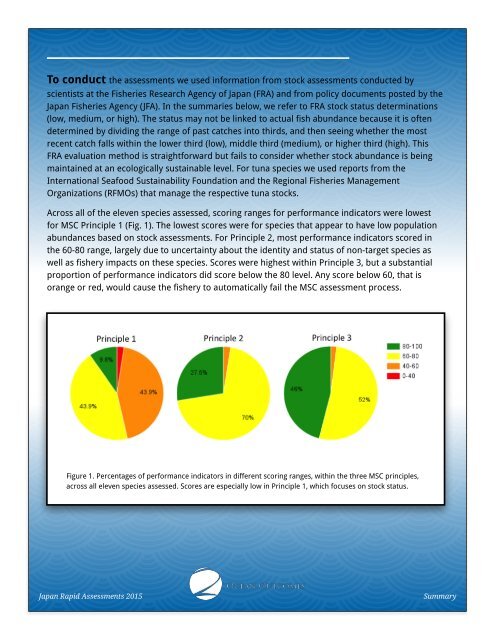OPPORTUNITIES
1WSDsgH
1WSDsgH
You also want an ePaper? Increase the reach of your titles
YUMPU automatically turns print PDFs into web optimized ePapers that Google loves.
To conduct the assessments we used information from stock assessments conducted by<br />
scientists at the Fisheries Research Agency of Japan (FRA) and from policy documents posted by the<br />
Japan Fisheries Agency (JFA). In the summaries below, we refer to FRA stock status determinations<br />
(low, medium, or high). The status may not be linked to actual fish abundance because it is often<br />
determined by dividing the range of past catches into thirds, and then seeing whether the most<br />
recent catch falls within the lower third (low), middle third (medium), or higher third (high). This<br />
FRA evaluation method is straightforward but fails to consider whether stock abundance is being<br />
maintained at an ecologically sustainable level. For tuna species we used reports from the<br />
International Seafood Sustainability Foundation and the Regional Fisheries Management<br />
Organizations (RFMOs) that manage the respective tuna stocks.<br />
Across all of the eleven species assessed, scoring ranges for performance indicators were lowest<br />
for MSC Principle 1 (Fig. 1). The lowest scores were for species that appear to have low population<br />
abundances based on stock assessments. For Principle 2, most performance indicators scored in<br />
the 60-80 range, largely due to uncertainty about the identity and status of non-target species as<br />
well as fishery impacts on these species. Scores were highest within Principle 3, but a substantial<br />
proportion of performance indicators did score below the 80 level. Any score below 60, that is<br />
orange or red, would cause the fishery to automatically fail the MSC assessment process.<br />
Figure 1. Percentages of performance indicators in different scoring ranges, within the three MSC principles,<br />
across all eleven species assessed. Scores are especially low in Principle 1, which focuses on stock status.<br />
Japan Rapid Assessments 2015<br />
Summary



